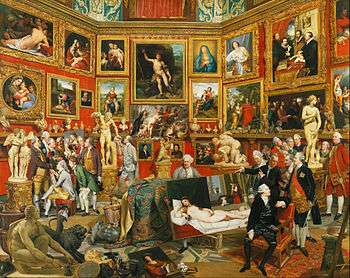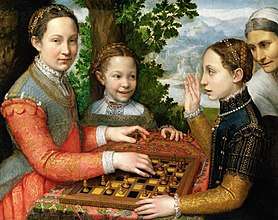Conversation piece
A conversation piece is an informal group portrait, especially those painted in Britain in the 18th century, beginning in the 1720s. They are distinguished by their portrayal of the group apparently engaged in genteel conversation or some activity, very often outdoors. Typically the group will be members of a family, but friends may be included, and some groups are of friends, members of a society or hunt, or some other grouping.[2] Often the paintings are relatively small, about the same size as a half-length portrait but in horizontal or "landscape" format; others are much larger.

Origins

The genre was developed from 17th century portraiture in the Low Countries.[3] The compositions of merrymaking companies (vrolijk gezelschap) and garden parties (buitenpartij) painted by artists such as Dirck Hals, David Vinckbooms, Adriaen van de Venne and Willem Buytewech were an important influence on the genre. In addition, representations of elegant companies and balls by Hieronymus Janssens and the works of Peter Paul Rubens, in particular his Garden of Love (Prado Museum), gave an impetus and direction to the development of the genre. In this last work, Rubens showed how a garden could be used as a setting for amorous dalliance and courtship.[4]
In the Low Countries many group portraits were painted, both of family groups and groups such as Governors or Regents of institutions, or militia officers. Frans Hals, Rembrandt and other artists had adopted a variety of poses to liven up the group portrait, for example the famous Night Watch. The name derives from the Italian term, also used in English, sacra conversazione for a similarly informal painting of the Virgin and Child with saints, a genre developed in the Renaissance.
Varieties

There are many varieties of conversation piece. People may be portrayed sharing common activities such as hunts, meals, or musical parties. Dogs and/or horses are also frequently featured. Arthur Devis was a regional painter famous for his small conversation pieces, popular with the gentry of Cheshire. William Hogarth also worked in the genre, and parodied it in his print A Midnight Modern Conversation, which depicted a group of men whose conversation has degenerated into drunken incoherence. Johann Zoffany specialized in complicated conversation pieces, and most portraits by George Stubbs take this form, with horses and carriages in the composition. Joshua Reynolds would on request produce conversation pieces in the Grand Manner, and at his usual near-life scale.
Conversation starters
The phrase "conversation piece" later acquired a different meaning. It came to refer to objects that were perceived to be interesting enough to spark conversation about them. They provide a stimulus for prop-based conversation openers. The original conversation pieces sometimes depicted a group united in conversation about an object, which would typically be an item linked to science or scholarship.
References and sources
- References
- http://www.artfund.org/supporting-museums/art-weve-helped-buy/artwork/3921/sir-george-and-lady-strickland-in-the-grounds-of-boynton-hall-arthur-devis
- Glossary: Conversation Piece. The National Gallery. Retrieved 7 December 2014.
- Gaunt, William. (1964) A concise history of English painting. London: Thames and Hudson, p. 58. ISBN 0500200165
- Mary Tavener, Nicolas Lancret: Dance Before a Fountain, Holmes Getty Publications, p. 13-14
- Sources
- Mario Praz, Conversation Pieces: A Survey of the Informal Group Portrait in Europe and America (University Park and London: The Pennsylvania State University Press, 1999)